Native to Asia, crape myrtles get their common name from their flowers, which resemble crepe fabric. Depending on the cultivar, crape myrtles range in size from 18-inch shrubs to treelike forms growing up to 40 feet tall and 15 to 25 feet wide. These plants are deciduous and have oblong, green, 2- to 4-inch-long leaves, with larger plants having larger leaves. During fall, crape myrtles brighten the landscape with their yellow, orange and red foliage.
Flowering begins in late spring or summer, although it starts earlier in warmer climates. Depending on the cultivar, large sprays of colorful clusters of blooms festoon the plant in shades of lavender, pink, red, white or purple. After crape myrtles flower, small, brown seeded fruits form. The plants produce multiple trunks and have a habit of producing suckers, although you can prune them to have one main trunk and a more treelike appearance. Crape myrtles grow at a moderate rate, with larger varieties putting on several feet in height during the growing season. As they grow, crape myrtles can be trained into a clump of trees or keep a shrub like form. This characteristic makes them perfect for a number situations, such as the center piece of a garden or yard, a backdrop in front of a fence, lining a drive, or planting on the corner of a house.
Crape-Myrtle grows best in full sun with rich, moist soil but will t tolerate less hospitable positions in the landscape just as well in limited soil spaces in urban areas such as along boulevards, in parking lots, and in small pavement cutouts if provided with some irrigation. They tolerate clay and alkaline soil as well.
- Catawba Crape Myrtle
- Tuscarora Crape Myrtle
- Muskogee Crape Myrtle
- Dynamite Crape Myrtle
- Sioux Crape Myrtle
- Pink Velour Crape Myrtle
- Natchez Crape Myrtle
- Cotton Crape Myrtle
- Tonto Crape Myrtle
- Red Rocket Crape Myrtle
- Arapaho Crape Myrtle
- Early Bird White Crape Myrtle
- Chickasaw Crape Myrtle
- Pocomoke Crape Myrtle
- Moonlight Magic Crape Myrtle
- Hopi Crape Myrtle
- Twilight Crape Myrtle
- Black Diamond Crape Myrtle
- Zuni Crape Myrtle
- Pecos or Comanche Crape Myrtle
- Acoma Crape Myrtle
- Biloxi Crape Myrtle
- Watermelon Crape Myrtle
- Coral Magic Crape Myrtle
- Sunset Magic Crape Myrtle
- Cherry Dazzle Crape Myrtle
- Double Feature Crape Myrtle
Catawba Crape Myrtle
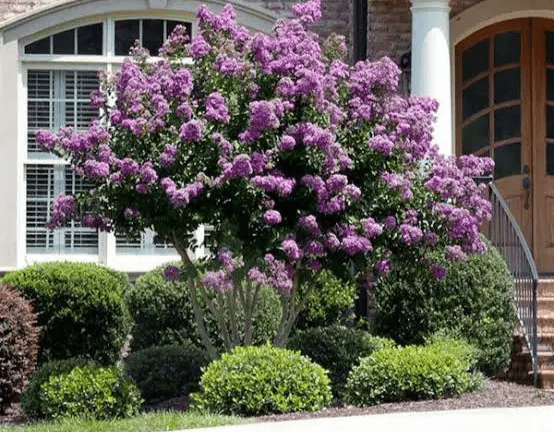
Catawba is one of the most noticeable medium sized, but not too big trees in the landscape. It is a striking Deep Violet color that stands out in any landscape. Catawba can be grown as a single trunk tree or multi-trunk large shrub. It matures 18ft tall and about 16ft wide. This crape myrtle enjoys a good disease resistance and adds great ornamental value across the seasons. It makes a striking specimen plant or flowering hedge.
Tuscarora Crape Myrtle

The Tuscarora is a tall crape myrtle with a broad crown and superior dark pink flowers. A long period of striking flower color, attractive fall foliage, fabulous, exfoliating bark and good drought-tolerance all combine to make this crape myrtle a favorite small tree for either formal or informal landscapes. It reaches a height of about 20 feet and experiences about 70 days of flowering. In the fall, the leaves turn a red-orange. All these qualities make the Tuscarora a great specimen tree, though it can also be planted in lines or groups.
Also Read: Different Types of Dogwood Trees
Muskogee Crape Myrtle
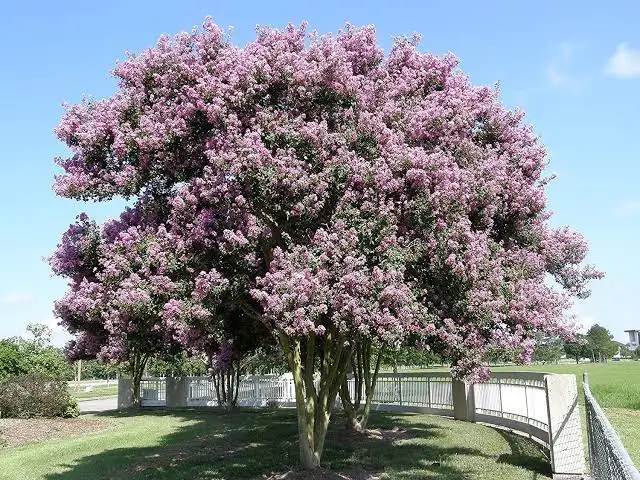
The Crape Myrtle Muskogee produces an impressive mature tree specimen. In 15 to 20 years, a Muskogee can reach a height of 30 feet and a width of 15-20 feet with a massive trunk caliper. Muskogee flowers are light lavender and very prolific, with an unusually long blooming period lasting up to 120 days. Foliage shows excellent vigor with glossy green leaves that are capable of turning bright red in autumn. Exfoliating bark is an attractive shiny light gray to tan color.
Dynamite Crape Myrtle
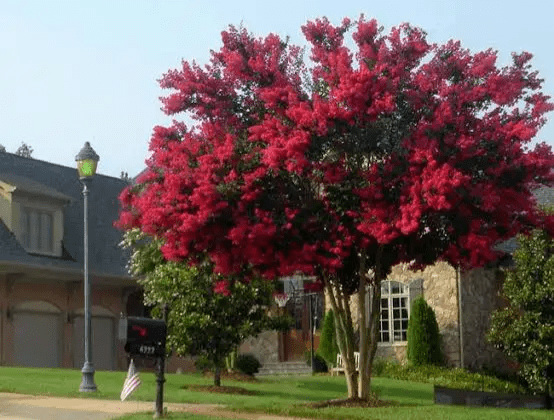
The dynamite crape myrtle grows to a height of 10–15′ and a spread of 12–20′ at maturity. It is a splendid, upright, deciduous tree with a profusion of large clusters, up to 14 inches long (35 cm), packed with crinkly, cherry red flowers at its branch tips. Blooming from midsummer to early fall in an explosion of red flowers smothering the foliage, it creates a remarkable display in the landscape. The foliage emerges crimson in spring, gradually matures to dark green, and turns orange and red shades in the fall before dropping – revealing the unique, smooth bark. This crape myrtle enjoys a good disease resistance and adds great ornamental value across the seasons. It makes a striking specimen plant.
Sioux Crape Myrtle
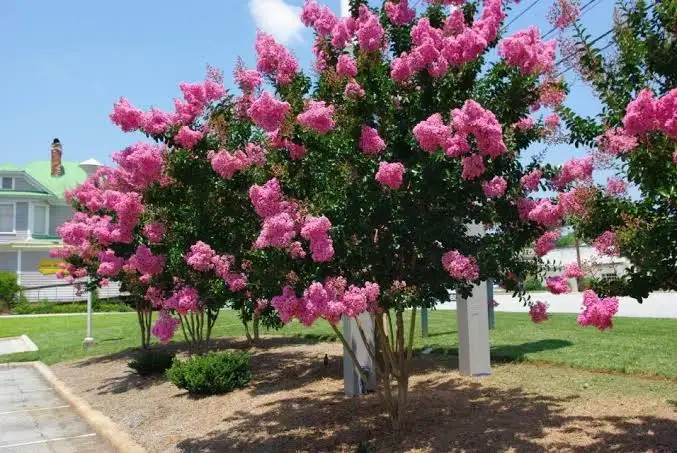
Sioux Crapemyrtle is a dense multi-stemmed deciduous shrub with an upright spreading habit of growth. It grows to be about 12 feet tall at maturity, with a spread of 10 feet. Sioux Crapemyrtle is smothered in stunning panicles of pink frilly flowers at the ends of the branches from early to late summer. It has attractive dark green deciduous foliage which emerges coppery-bronze in spring. The oval leaves are highly ornamental and turn orange in fall. Sioux Crapemyrtle makes a fine choice for the outdoor landscape, but it is also well-suited for use in outdoor pots and containers. Its large size and upright habit of growth lend it for use as a solitary accent, or in a composition surrounded by smaller plants around the base and those that spill over the edges. It is even sizeable enough that it can be grown alone in a suitable container.
Also Read: Popular Types of Cherry Trees For Your Home
Pink Velour Crape Myrtle

Considered a semi-dwarf crape myrtle variety, these flowering plants reach a height of 5 to 12 feet. The “Pink Velour” crape myrtle, with a mature height of approximately 10 feet, is regarded as one of the most colorful varieties, it bears abundant clusters of crinkly, vibrant magenta-pink flowers at its branch tips for months, from midsummer to early fall. This attractive deciduous shrub or small tree also features thick and leathery leaves that emerge burgundy red in spring, mature to purplish green by summer and finally turn orange-brown in fall. The grayish-brown bark on mature branches exfoliates with age, adding further interest in the landscape. In addition to its visual appeal, crape myrtles tolerate a variety of cultural conditions making the “Pink Velour” a well-suited specimen for both suburban and urban landscapes.
Natchez Crepe Myrtles

The Natchez Crape Myrtle is a hybrid between the Japanese Crape Myrtle (Lagerstroemia faurei) and the common Crape Myrtle (Lagerstroemia indica), which was developed by the US National Arboretum in 1978. Natchez crepe myrtles grow as trees and can get to be over 30 feet tall with a striking, vase-shape and a profusion of large clusters, up to 12 inches (30 cm), packed with ruffled and crinkly, pure white flowers at its branch tips. Blooming in mid to late summer, they create a brilliant display in the landscape. The crepe-papery flowers give way to round seed capsules which often persist well into winter. The foliage of dark green leaves turns orange and red shades in the fall before dropping – revealing the smooth, rich cinnamon-brown, peeling bark.
Cotton Crape Myrtle
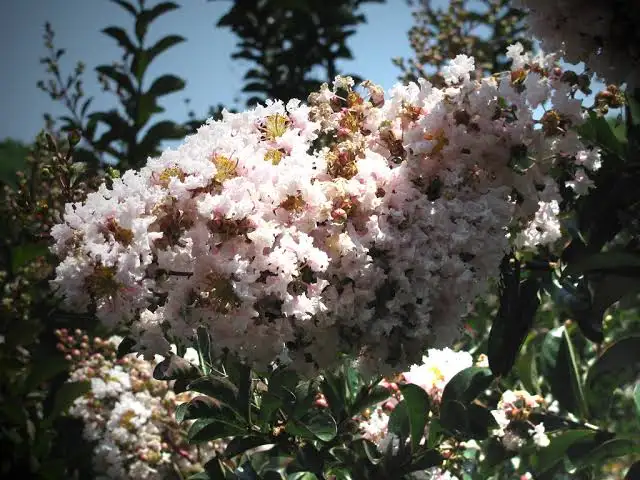
Cotton Crape Myrtle is a splendid, upright, rounded, shrub or small tree with a profusion of large clusters packed with crinkly, white flowers opening from showy burgundy flower buds. Blooming from early summer to early fall, the flowers contrast nicely against the wine-red coloring of the new foliage growth. It continues to bloom on new growth once daytime temperatures reach 85°F (30°C) for a sustained period of time. Heat and drought tolerant, this crape myrtle enjoys a good disease resistance and adds great ornamental value across the seasons. It makes a striking specimen plant or flowering hedge.
Also Read: Different Types of Beautiful Maple Trees
Tonto Crape Myrtle

Tonto crape myrtle won the Georgia Gold Medal (1996) and Mississippi Medallion (1999) for faithful, long lasting beauty and resilience in hot climates. This hybrid grows to about 10 feet tall and will bring bursts of fuchsia pink to your yard from summer until fall. It experiences about 75-days of beautiful dark pink blooms in the summer. This small tree has a gorgeous growth habit with dark green leaves which offer further interest after the flowering period when they change to orange before falling. Bark is a rich, brown colour which reveals a lighter coloured underbark, creating a mottled effect as the tree matures. The Tonto Crape Myrtle is a perfect choice if you want a colorful, small tree for yard borders or hedging.
Red Rocket Crape Myrtle
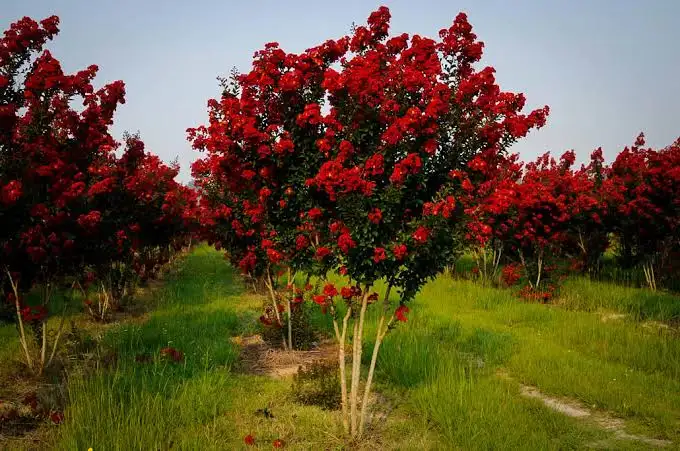
The Red Rocket Crape Myrtle is a splendid, rounded tree with a profusion of large clusters, up to 24 inches (60 cm), packed with crinkly, brilliant cherry-red flowers at its branch tips. Blooming in mid to late summer, they create a brilliant display in the landscape. The foliage emerges crimson in spring, gradually matures to dark green, and turns orange and red shades in the fall before dropping – revealing the unique, smooth bark. Highly disease resistant, this crape myrtle adds great ornamental value across the seasons. The Red Rocket Crape Myrtle will reach heights up to 25 feet tall, and 10 feet wide and makes a striking specimen plant.
Arapaho Crape Myrtle

The Arapaho Crape Myrtle is a small tree that will reach 20 feet tall and 10 feet wide in around 15 years. This flowering tree was developed by the National Arboretum for increased powdery mildew resistance and drought tolerance. Arapaho myrtle offers year-round interest with its glossy, dark green leaves, beautiful exfoliating bark, and panicles of near true red flowers. The large clusters of dark, watermelon-red flowers begin to appear in late spring and continue throughout summer, sometimes even into fall providing a spectacular show in the landscape. Arapaho is great for use in small groupings or as a single specimen, as a colorful screen or hedge, on the corners to frame in homes and other structures, or planted on both sides of an entryway.
Early Bird White Crape Myrtle
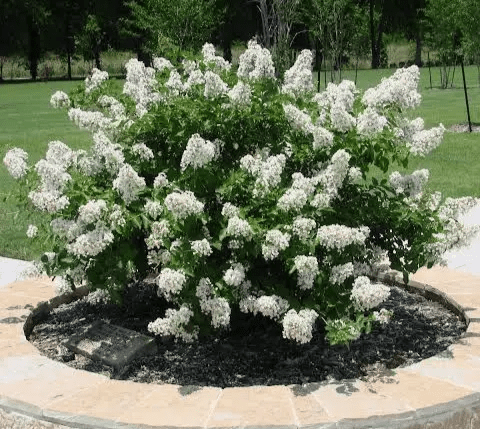
Early Bird White Crape Myrtle is a deciduous shrub or small tree prized for its long blooming season, fast growth rate and spreading to weeping form, Early Bird White is an upright, multi-stemmed, deciduous shrub with abundant clusters of pure white flowers at its branch tips, from late spring (sometimes as early as Mother’s Day) to fall. It is referred to as an early bird because it starts blooming much earlier than other crape myrtles. It also exhibits excellent reblooming capabilities, it repeats flowering throughout the summer for up to 120 days. The flowers stand out against the fresh green foliage, which turns sometimes golden yellow in the fall. Equally attractive is the exfoliating gray-brown bark on mature branches. This Crape Myrtle variety is a perfect choice if you want a colorful, small tree for yard borders or hedging.
Also Read: Popular Types of Flowering Trees
Pocomoke Crape Myrtle
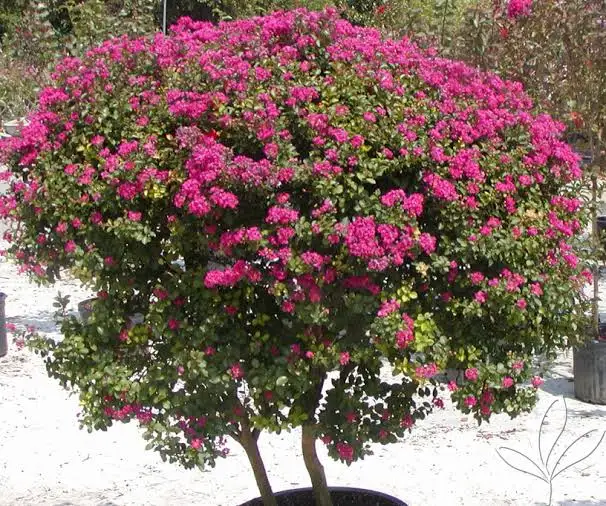
The Pocomoke Crape Myrtle is a delightful new, dwarf Crape Myrtle that is idea for smaller gardens or for mass-planting in larger ones. It grows no more than two four feet tall and three feet across and it can be grown for years as a container plant, making it an ideal choice for terraces and balconies even if you have no garden at all. It can be grown from zone 6 up into all the warmer parts of the country.
This Crape Myrtle has deep rose-pink flowers from early summer right to the end of fall and provides continuous bloom. In fall the leaves will turn beautiful shades of bronzy-red, adding to the interest created by this beautiful little plant. Despite its size this is a tough, drought-resistant plant that will thrive in hot, sunny locations.
Moonlight Magic Crape Myrtle

Moonlight Magic Crape Myrtle is an upright, vase shaped, shrub or small tree with abundant clusters of crinkly, pure white lacy blooms at its branch tips in midsummer to early fall. They emerge amidst the superb deep purple maroon foliage which does not fade in the southern heat. Highly resistant to leaf spot and powdery mildew, it makes a great specimen plant or flowering hedge, thanks to the beauty of its dark foliage. Perfect for small gardens.
Hopi Crape Myrtle

The Hopi Crape Myrtle is a medium-sized deciduous shrub that will grow 7 or 8 feet tall, and about 10 feet across. From summer to fall it is smothered in a continuous display of bright-pink flowers, in large clusters, that will brighten your garden month after month. In fall the leaves turn vibrant shades of red, orange and gold, and the mottled winter bark is attractive too. This easy-care shrub will grow in hot, sunny places, and it is very drought-resistant once established. Grow it as a lawn specimen, as an informal hedge or screen, or in a sunny border among other shrubs. Whatever way you use it in your garden, you will love the continuous colorful blooming, with so little care needed for such a big return.
Also Read: Major Trees With Pink Flowers
Twilight Purple Crape Myrtles

Twilight Crape Myrtle trees grow as multi-stemmed shrubs with upright branches, but they can be pruned to a single-stemmed, more tree-like structure. Their oval leaves provide year-round interest—bronze in the spring transitioning to green in the summer and orange and red in the fall. They stand out for their crinkly, deep-purple flowers—the deepest purple blooms of any crape myrtle tree. Even after the blossoms fade and the leaves fall in autumn, the bare trunks of mature Twilight Crape Myrtle trees bring architectural beauty to the landscape with their mottled bark. Twilight Purple Crape Myrtles grow up to 20-25 feet tall, with a spread of 10-15 feet making it a popular choice for lining driveways, roadways, fences, or in groupings, and also, as a stunning stand-alone ornamental for your yard.
Black Diamond Crape Myrtle
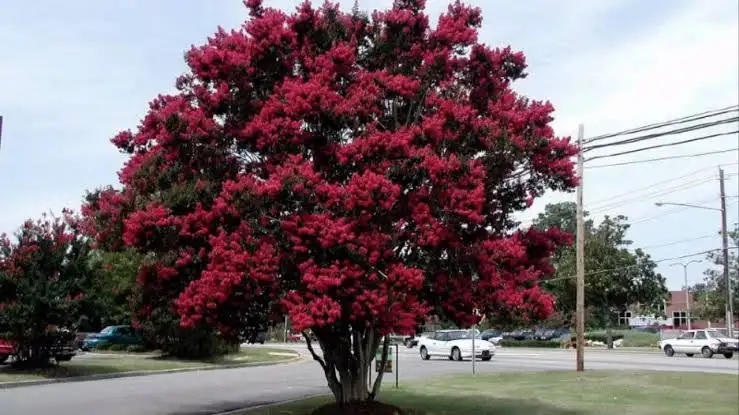
The Black Diamond Crape Myrtle variety represents the first series of true dark-leafed crape myrtles. The blooms of the Crimson Red Black Diamond come in a vibrant crimson red blooms with bright yellow centers which offset the intense hues of the dark leaves. When Crimson Red first starts to bloom, the bloom may appear white but will darken once fully opened. As with any bloom, as time progresses the bloom will fade. The bright blooms of the Black Diamond reach their productivity peak during the summer and fall months. This variety has been described as having an intermediate growth habit, reaching 10 to 12 feet tall, a spread of 6 to 8 feet, and can be used as a specimen or in mass plantings. Crape Myrtles look particularly nice when lining driveways or fences, and can also be planted in a container on your deck or patio as long as the container is large enough.
Zuni Crape Myrtle

Zuni Crapemyrtle is a dense multi-stemmed deciduous shrub with a more or less rounded form. It grows to be about 12 feet tall at maturity, with a spread of 10 feet. The blooms of this crape myrtle are a magnificent display that attract flocks of hummingbirds and butterflies through the summer months. These purple crape myrtles produce 6 to 12 inches clusters of purple flowers that can last for many weeks or even months. The leaves of crape myrtles are a unique glossy red/green and the growth rate of a crape myrtle is incredible, these trees can create shoots of new growth of more than a foot in just a few short weeks. As they grow, crape myrtles can be trained into a clump of trees or keep a shrub like form. This characteristic makes them perfect for a number situations, such as the center piece of a garden or yard, a backdrop in front of a fence, lining a drive, or planting on the corner of a house.
Pecos Crape Myrtle
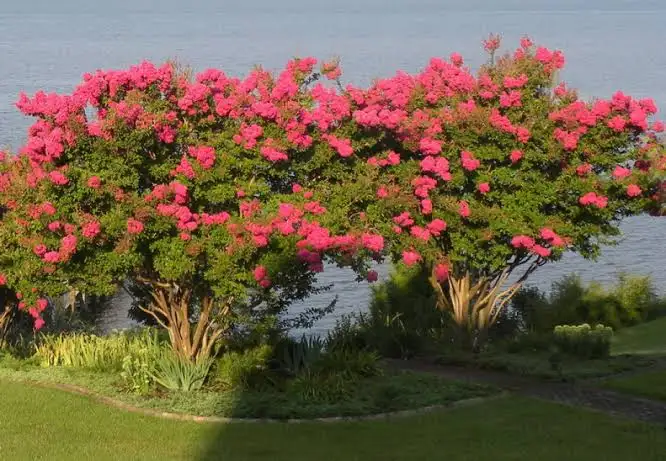
Pecos also referred to as Comanche Crape Myrtle is a small, upright, broad-spreading, deciduous tree with a profusion of large clusters, 6-9 inches long (15-22 cm), packed with crinkly, coral pink flowers at its branch tips. Blooming from midsummer to early fall in an explosion of brilliant flowers smothering the foliage, it adds vibrant color in the landscape. The foliage of dark green leaves turns orange to reddish purple in the fall before dropping – revealing the unique, smooth bark. This crape myrtle enjoys an excellent disease resistance and adds great ornamental value across the seasons. It makes a striking specimen plant or flowering hedge.
Also Read: Different Types of Shade Trees For Your Garden
Acoma Crape Myrtle

Acoma Crape Myrtle variety only attains a height of up to 10 to 15 feet or so and is frequently reported as staying small in size and being more shrub-like instead of appearing like a tree. It grows by about 1 to 2 feet per year. The crape myrtle is a great option for planting in urban or suburban environments. Its small size makes it ideal for gardens or lawns, or it can be used as part of a commercial landscaping plan. Before planting, make sure that the full grown tree won’t cause issues on the property since the tree cannot be topped. You cannot cut off the top of the tree to control the height; that will kill the tree (“crape murder,” as it’s known).
Biloxi Crape Myrtle
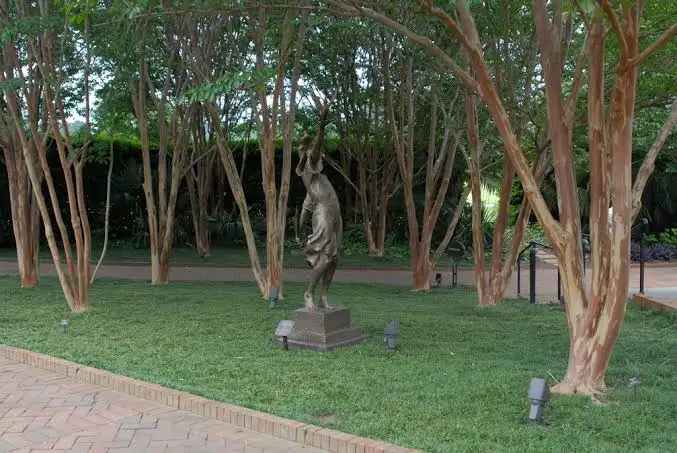
Biloxi Crape Myrtle also referred to as Lipan crape myrtle is an upright, spreading, shrub or small tree with a profusion of large clusters packed with crinkly, lavender-pink flowers at its branch tips. Blooming all summer long in an explosion of brilliant flowers smothering the foliage, it adds vibrant color in the landscape. The foliage of dark green leaves turns orange and red in the fall before dropping – revealing the unique, smooth bark. This crape myrtle enjoys an excellent disease resistance and adds great ornamental value across the seasons. It makes a striking specimen plant or flowering hedge.
Watermelon Crape Myrtle

Watermelon Crape Myrtle is a dwarf, deciduous shrub with abundant clusters of crinkly, brilliant watermelon-pink flowers at its branch tips in mid to late summer. They emerge amidst the green foliage which provides interest in spring before the blooming season begins. The leaves turn shades of yellow, red, and orange in the fall before dropping – revealing the handsome, peeling bark of the winter stems. The petite stature of this crape myrtle makes it ideal for small gardens and containers on your balcony or patio.
Coral Magic Crape Myrtle
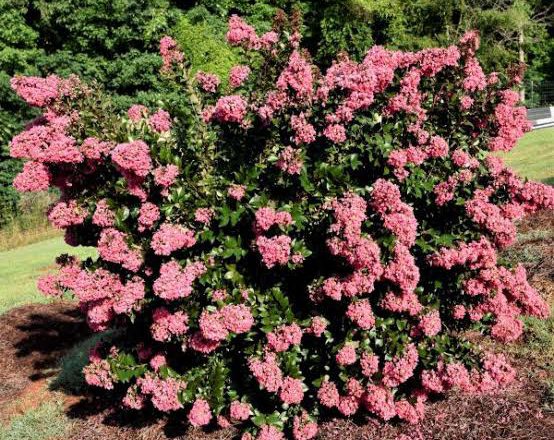
Coral Magic Crape Myrtle is a compact, shrub with abundant clusters of crinkly, vivid salmon-pink flowers at its branch tips in early summer. They emerge amidst the spring foliage of bold, red tinted new leaves, creating a brilliant display. In the heat of summer, the foliage gradually matures to brilliant green, setting off the rich coral flowers. This crape myrtle will rebloom in late summer if the first flush of flowers are deadheaded. Highly resistant to leaf spot and powdery mildew, it makes a great specimen plant or flowering hedge, thanks to the sheer intensity of its coral-pink blossoms.
Sunset Magic Crape Myrtle
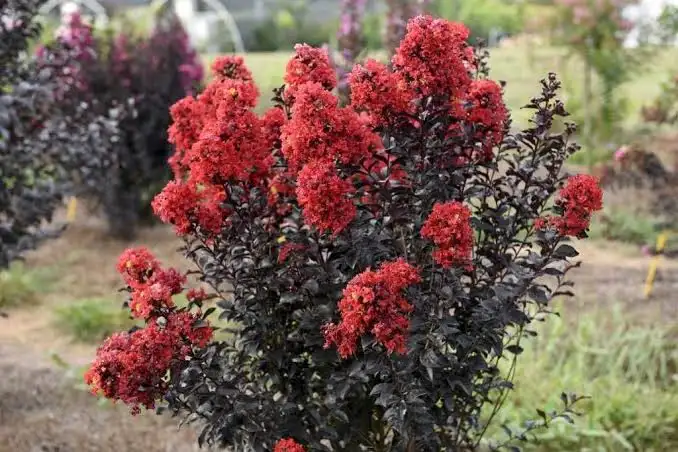
Sunset Magic Crape Myrtle is a small, shrub with abundant clusters of crinkly, cherry-red flowers at its branch tips. The flowers form in prodigious quantities, virtually shrouding the lustrous foliage of deep purple-black leaves, which holds its dark color into late summer. Highly resistant to leaf spot, powdery mildew and Cercospora, this crape myrtle makes a great specimen plant or flowering hedge, thanks to the beauty of its dark foliage and fiery flowers. Perfect for small gardens.
Also Read: Major Types of Deciduous Trees For Your Home
Cherry Dazzle Crape Myrtle
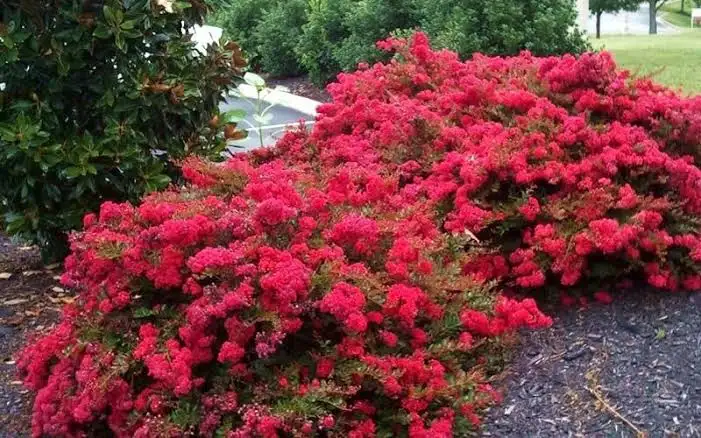
Cherry Dazzle Crape Myrtle is a dwarf, rounded, shrub with abundant clusters of crinkly, brilliant cherry-red flowers at its branch tips all summer long. They emerge amidst the glossy foliage which provides interest in spring before the blooming season begins. The leaves turn burgundy-red in fall before dropping – revealing the gray and tan bark of the winter stems. The petite stature of this crape myrtle makes it ideal for small gardens and containers on your balcony or patio.
Raspberry Sundae Crape Myrtle
Raspberry Sundae Crape Myrtle is a splendid, upright, shrub or small tree with a profusion of large clusters packed with crinkly, raspberry red flowers with white margins at its branch tips. Blooming from midsummer to early fall in an explosion of bicolor flowers smothering the foliage, it creates a remarkable display in the landscape. The foliage emerges bronze in spring, gradually matures to mid-green as the season progresses. This crape myrtle enjoys a good disease resistance and adds great ornamental value across the seasons. It makes a striking specimen plant or flowering hedge.
Double Feature Crape Myrtle

Double Feature Crape Myrtle is a splendid, upright, rounded, shrub with a profusion of large clusters packed with crinkly, ruby-red flowers at its branch tips. Blooming from early summer to early fall in an explosion of bright flowers smothering the foliage, it creates a remarkable display in the landscape. The foliage emerges wine-red in spring, gradually matures to deep green as the season progresses. This crape myrtle does not produce seed. It enjoys a good disease resistance and adds great ornamental value across the seasons. It makes a striking specimen plant or flowering hedge.
Planting And Caring For Crape Myrtle Trees And Shrubs
Plant crape myrtle in moderately fertile, well-drained soil with a pH between 5.0 and 6.5. Crape myrtle prefers full sun but will tolerate light shade, albeit with reduced blooming. If you live at the colder end of crape myrtle’s hardiness range, you can help it withstand chilly winters by planting it against a south-facing wall where it will receive the most warmth and sunlight.
When conditions are right for planting, dig a hole that is wide enough to accommodate crape myrtle’s entire root system. It’s better to create a hole too wide than not wide enough, but don’t dig too deep. The plant should rest so that the base of the trunk is flush with the ground. Fill the hole back in, compacting the soil just enough to eliminate air pockets, but not so much as to cramp the roots. Once established, crape myrtle can tolerate drought, but it requires generous amounts of water at the time of planting.